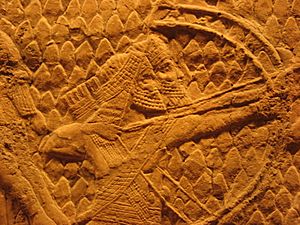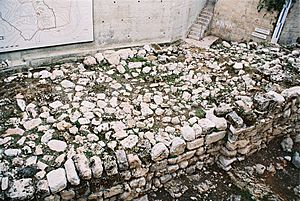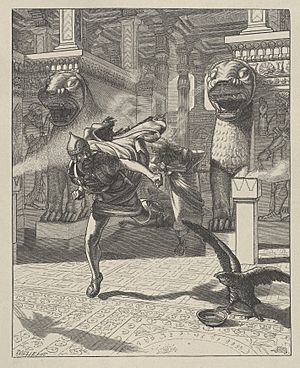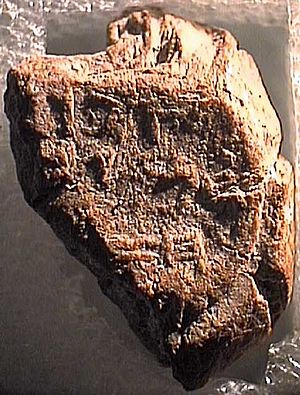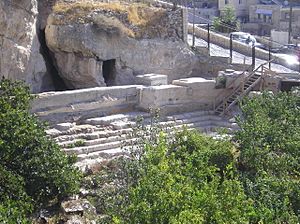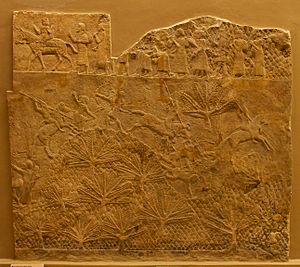Hezekiah facts for kids
Quick facts for kids Hezekiah |
|
|---|---|
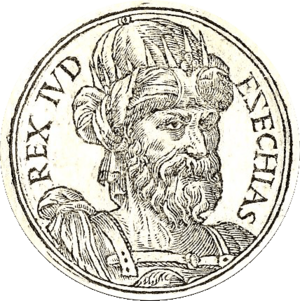
King Hezekiah from Guillaume Rouillé's Promptuarii Iconum Insigniorum, 1553
|
|
| King of Judah | |
| Reign | Uncertain, reign ended c. 687 BCE |
| Predecessor | Ahaz |
| Successor | Manasseh |
| Born | c. 739/41 BCE probably Jerusalem |
| Died | c. 687 BCE (aged 51–54) probably Jerusalem |
| Burial | Jerusalem |
| Spouse | Hephzibah |
| Issue |
|
| House | House of David |
| Father | Ahaz |
| Mother | Abijah (also called Abi) |
Hezekiah (/ˌhɛzɪˈkaɪ.ə/; Biblical Hebrew: חִזְקִיָּהוּ, romanized: Ḥīzqīyyahū), also known as Ezekias, was an important king of Judah. His name means "Yahweh strengthens" or "Yahweh is my strength" in Hebrew. Hezekiah was the son of King Ahaz and became the 13th king of Judah. He was born around 741 BCE and ruled from about 716/715 BCE until 687/686 BCE.
During his time as king, Hezekiah saw the northern Kingdom of Israel fall to the Assyrians around 722 BCE. He was also king when the Assyrian army, led by Sennacherib, attacked Jerusalem in 701 BCE. Hezekiah is known for making big religious changes. He made sure that only Yahweh was worshipped and removed other gods from the Temple of Jerusalem. The Bible describes him as a very good and righteous king. He is also mentioned in the genealogy of Jesus.
Contents
Who was King Hezekiah?
His Family and Early Life
Hezekiah was the son of King Ahaz and Abijah. His mother, Abijah, was the daughter of a high priest named Zechariah. Hezekiah married a woman named Hephzibah. He died around 687 BCE when he was about 54 years old. His son, Manasseh, became king after him.
How Long Did He Rule?
The Bible says Hezekiah became king at age 25 and ruled for 29 years. Some historians believe he might have ruled alongside his father, Ahaz, for about 14 years before becoming the sole king. His main reign is often dated from 715 BCE to 687 BCE.
What Religious Changes Did Hezekiah Make?
Restoring the Temple
According to the Bible, Hezekiah cleaned and fixed the Temple in Jerusalem. He removed idols and reformed the priesthood. He wanted to stop people from worshipping idols in his kingdom. He destroyed the "high places" (special altars) and even a "bronze serpent" (called Nehushtan) that Moses had made. This serpent had become an object of worship.
Hezekiah made Jerusalem's Temple the main place for worshipping God. He also brought back the Passover celebration. He invited people from the scattered tribes of Israel to join the festival. The Bible says this Passover was celebrated with great joy, like nothing seen since the days of Solomon.
How Did Hezekiah Deal with Assyria?
Facing the Assyrian Invasion
After the Assyrian king Sargon II died in 705 BCE, his son Sennacherib became king. Sennacherib started military campaigns to stop people from opposing Assyrian rule. In 701 BCE, he turned his attention to the western cities, including Judah. King Hezekiah had to prepare for an invasion. The Bible says Hezekiah trusted in God for help, rather than relying on Egypt.
The Assyrians said that Sennacherib stopped his attack on Jerusalem after Hezekiah paid him a large tribute. The Bible says Hezekiah paid 300 talents of silver and 30 talents of gold. He even sent the doors of the Temple to meet the payment. However, even after this payment, Sennacherib continued his attack on Jerusalem.
Sennacherib surrounded the city and sent his Rabshakeh (a high-ranking official) to speak to the people on the city walls. The Rabshakeh spoke in Hebrew, telling the soldiers not to trust God or Hezekiah. He claimed that Hezekiah's religious reforms meant God would not help them. The Bible says Hezekiah went to the Temple and prayed to God for help.
Hezekiah's Preparations for Siege
Knowing that Jerusalem might be attacked, Hezekiah had been preparing for a long time. He made the city walls stronger, built towers, and created a special tunnel. This tunnel brought fresh water into the city from a spring outside the walls. He built the Siloam Tunnel and the Broad Wall to help Jerusalem survive a siege.
Hezekiah talked with his officers about blocking the springs outside the city. They wanted to make sure the Assyrian king would not find plenty of water if he came.
The Battle with Sennacherib's Army
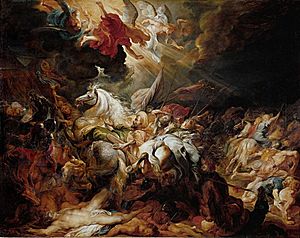
The Bible says Sennacherib sent threatening letters to Hezekiah, saying he would still capture Jerusalem. Even though they surrounded Jerusalem, the Bible states that the Assyrians did not even "shoot an arrow" or build a "siege rampart" against it. The Bible says God sent an angel who struck down 185,000 Assyrian soldiers in one night. This forced Sennacherib to return to his own land "with shame."
Sennacherib's own records do not mention this disaster. However, historians note that Assyrian kings usually only wrote about their victories. The Sennacherib Prism, an ancient Assyrian record, says: "As to Hezekiah, the Jew, he did not submit to my yoke... Hezekiah himself... did send me, later, to Nineveh, my lordly city, together with 30 talents of gold, 800 talents of silver..." This record confirms that Hezekiah paid tribute but does not claim that Sennacherib captured Jerusalem.
The Death of Sennacherib
Assyrian records show that Sennacherib was killed in 681 BCE, about 20 years after his invasion of Judah. A letter from Babylon also supports the idea that Sennacherib's sons wanted to kill him. Historians believe his son, Arda-Mulissu, murdered him. This might be the "Adrammelech" mentioned in the Bible. The murder likely happened because another son, Esarhaddon, was chosen to be king instead of Arda-Mulissu.
Hezekiah's Illness and Recovery
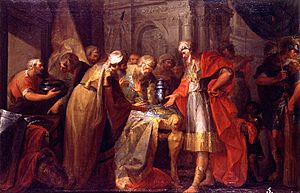
Later in his life, Hezekiah became very sick with a boil. The prophet Isaiah told him that God said he would die and should prepare his affairs. But Hezekiah prayed to God, and Isaiah returned, saying God had heard his prayer and he would recover. Hezekiah asked for a sign. Isaiah asked if the shadow on a sundial should go forward or backward ten degrees. Hezekiah chose backward, and the Bible says the shadow moved back ten degrees.
After his recovery, messengers came to congratulate him, including some from the king of Babylon. Hezekiah, feeling proud, showed them all the wealth, weapons, and supplies in Jerusalem. Isaiah then told him that because he showed off his treasures, a future generation of Judah's people would be taken captive to Babylon. Hezekiah was told that there would be peace during his own lifetime.
According to the Bible, Hezekiah lived another 15 years after his prayer. His son, Manasseh, who became king after him, was born during this time.
What Do Records Outside the Bible Say?
Archaeological Discoveries
Many non-biblical sources mention Hezekiah by name, confirming his reign and influence. His time as king is one of the best-documented periods in ancient history, with information from the Bible, Assyrian records, and archaeological finds.
- Royal Seal: A seal impression from 727–698 BCE was found in Jerusalem. It reads: "Belonging to Hezekiah [son of] Ahaz king of Judah." This is the first seal of an Israelite or Judean king found in a scientific excavation. It shows that the ancient kingdom of Judah had a well-organized government.
- LMLK Jars: Special jars marked "LMLK" (meaning "to the king") were found near the border with Assyria. These jars show that Hezekiah prepared carefully for Sennacherib's invasion. They also suggest that the king had strong control over his towns and cities.
- Jerusalem's Growth: During Hezekiah's reign, the kingdom of Judah became much stronger. Jerusalem grew a lot, with its population increasing to about 25,000 people. This was five times more than under King Solomon. Archaeologists believe this growth was due to many Israelites fleeing from the Assyrian destruction of the northern kingdom.
The Siloam Tunnel Inscription
The Siloam Tunnel was dug through 533 meters (1,750 feet) of solid rock. It brought water from the Gihon Spring into Jerusalem, providing a hidden water source during sieges.
The Siloam Inscription, found in the tunnel, describes the moment when two teams of diggers, working from opposite ends, met in the middle. This inscription is one of the most important ancient Hebrew writings ever found. It shows how advanced Jerusalem was at that time.
The Lachish Relief
Lachish was the second most important city in Judah. When King Hezekiah rebelled against Assyria, Sennacherib captured Lachish after a tough fight.
The Lachish relief is a large stone carving found in the Assyrian palace at Nineveh. It clearly shows the battle and defeat of Lachish. It depicts Assyrian archers attacking and Judahites being captured. This relief was huge, showing the power of the Assyrian army.
Sennacherib's Prism
Sennacherib's Prism is a clay object found buried in the foundations of the Nineveh palace. It is written in cuneiform, an ancient Mesopotamian writing. The prism describes Sennacherib's conquest of 46 strong towns and many smaller places. It also mentions the siege of Jerusalem, where Sennacherib says he "shut him up... like a bird in a cage." He then forced Hezekiah to pay a larger tribute.
The Bible says that after the siege, Hezekiah paid 300 talents of silver. Sennacherib's prism claims 800 talents of silver. This difference might be due to different ways of measuring silver or the Assyrian habit of exaggerating their victories. However, both accounts agree that Sennacherib did not capture Jerusalem.
Other Historical Mentions
The Greek historian Herodotus (who lived around 484–425 BCE) wrote about the Assyrian invasion. He also mentioned many Assyrian deaths, which he said were caused by a plague of mice. The Jewish historian Josephus also wrote about this. These historians agree that Sennacherib failed to capture Jerusalem.
Jewish tradition says that Hezekiah helped put together the biblical books of Isaiah, Proverbs, Song of Songs, and Ecclesiastes. It is also believed that the victory over the Assyrians and Hezekiah's recovery from illness happened at the same time, on the first night of Passover.
|
See also
 In Spanish: Ezequías para niños
In Spanish: Ezequías para niños


